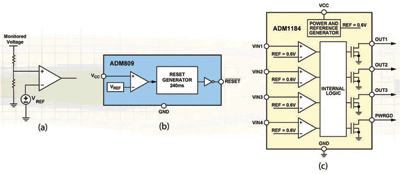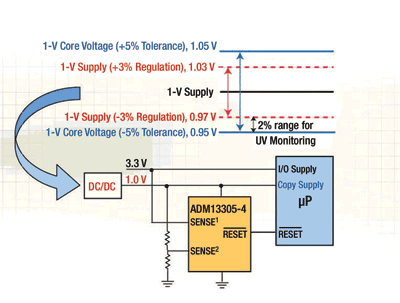Ensuring reliable operation in multivoltage systems
Increasing complexity and the methods addressing them
BY NORMA O’MAHONY
Analog Devices, Norwood, MA
http://www.analog.com
As more functionality is placed in smaller form factors, advanced communications and computing markets continually demand technological improvements that lower costs and increase capabilities. These requirements result in higher levels of complexity per board. It is increasingly common to find several multivoltage devices coexisting in a single design that contains such devices as ASICs, FPGAs, and DSPs.
The result has been a spiraling increase in the number of power supplies per card. High-end systems with more than 20 voltage rails on a board are now common. Only a few years ago, these would have comprised numerous boards with approximately four supplies each. Today’s electronics designers face a challenging problem: how to ensure that 99.999% system reliability is maintained as power chain complexity increases.
The number of voltage rails in complex systems has increased dramatically in recent years, due to the development of new processes using lower supply voltages, coupled with legacy I/O voltage requirements. A single board may comprise microprocessors, FPGAs, and ASICs, along with analog and digital circuit elements.
Monitoring and controlling the ever-increasing number of voltage rails is fundamental for the safe, robust, and reliable operation of the system over its lifetime. As the number of voltage rails increases, the probability of a fault occurring increases proportionately.
A growing trend toward lower core voltages is being driven by new smaller process geometries. Low voltages need to be delivered efficiently — often at high current — and must conform to stringent regulation and transient specifications. A lack of headroom at low voltages can cause devices to behave unpredictably. If the power supply voltage drops below the threshold for a telecommunications ASIC, for example, it can operate erratically, possibly resulting in a corrupt message being sent or the loss of data.
Available methods
Numerous methods exist to monitor system voltages, the most basic being a discrete circuit (see Fig. 1a ). It employs a precise resistor-divider network, a comparator, and a reference voltage, allowing it to determine if the voltage rail being monitored is below a preset threshold. This method is costly, inaccurate, susceptible to noise, and results in a large footprint.

Fig. 1. Shown above are three common methods to monitor system voltages.
IC voltage supervisors address the issues associated with the discrete voltage-monitoring implementation. A typical voltage-monitoring device (see Fig. 1b ) incorporates a voltage reference, a comparator, a supply voltage resistor string, a reset timeout generator, and an output driver stage.
The resistor network can be pre-trimmed at the manufacturing stage to suit a wide range of voltage thresholds. Such devices typically offer threshold accuracy of 2.5% and can monitor voltages as low as 1.58 V.
As core voltages drop below 1 V, this level of accuracy and choice of reset threshold becomes inadequate. The local generation of supplies specific to a particular function leads to the clustering of voltage rails within a chipset, making integrated multivoltage supervisory devices a cost-effective, space-efficient solution.
A quad voltage monitor (see Fig. 1c ), also reduces the amount of analog routing required on the board. Multivoltage supervisory devices are available with a range of input voltage thresholds. Some feature pre-trimmed fixed threshold options that do not require external resistors. Others are more flexible, with adjustable thresholds capable of monitoring voltages as low as 0.60 V that can simply be programmed using an external resistor divider.
Adjustable inputs with high reset threshold accuracy of 0.8% are available. Multivoltage devices that combine pre-trimmed and adjustable input thresholds are often the most versatile.
Voltage headroom becomes a limitation in low voltage supply applications. At low voltage, the tolerance required to reliably switch on-chip gates is much tighter. The reset threshold accuracy of the voltage monitor is the most critical consideration when choosing a multivoltage monitor, especially when monitoring lower voltages. Consider the system depicted in Fig. 2 .

Fig. 2. High threshold accuracy allows 2% range for over/undervoltage monitoring
A 1-V regulated supply produces a voltage that varies between 0.97 and 1.03 V. The microprocessor’s 1-V core supply voltage has a tolerance of ±5%, therefore it requires a voltage level between 0.95 and 1.05 V to maintain reliable operation. A voltage range of just 2% remains, between 0.95 and 0.97 V, for undervoltage monitoring. In order to supervise the 1-V supply voltage precisely, a voltage supervisor offering high accuracy is a necessity.
The ADM13305-4 dual-voltage supervisor, with 0.8% threshold accuracy, and ±0.1% accurate resistors in the voltage divider at the SENSE2 input, combine to provide accurate monitoring of the under-voltage level within this 2% range. Inferior threshold accuracy would cause an overlap of the supervisor’s reset threshold range and the power supply tolerance range, resulting in nuisance resets even if the power supply were within its specified regulation range. To offset inferior threshold accuracy an increased voltage range would be required for robust system operation.
Noise on the monitored voltage rail, a possible consequence of power supply ripple or system transients, can cause false resets, especially when the monitored voltage is close to the reset threshold. Tightening the voltage headroom at lower voltages means the traditional technique of adding hysteresis to the input comparator is no longer satisfactory.
At low voltages, glitch filtering is a more efficient form of noise filtering that ensures predictable operation and eliminates false triggering of the reset, without degrading the device’s accuracy. If a glitch shorter than the specified filter timeout appears on the input, the pulse is masked and the signal change does not appear on the reset output.
High-accuracy multivoltage monitors offer a simple, precise, cost-efficient method of ensuring reliable operation in complex multivoltage systems, while minimizing the board space required and limiting spurious system resets. Multivoltage monitors ease design challenges by minimizing the overall voltage range required for dependable system operation.
For more on multivoltage systems, visit http://www2.electronicproducts.com/AnalogMixICs.aspx.
Advertisement
Learn more about Analog Devices





